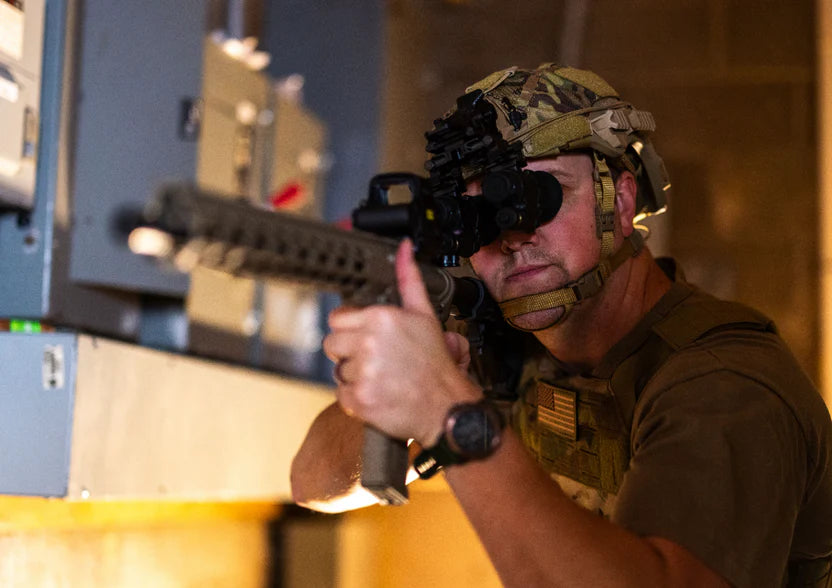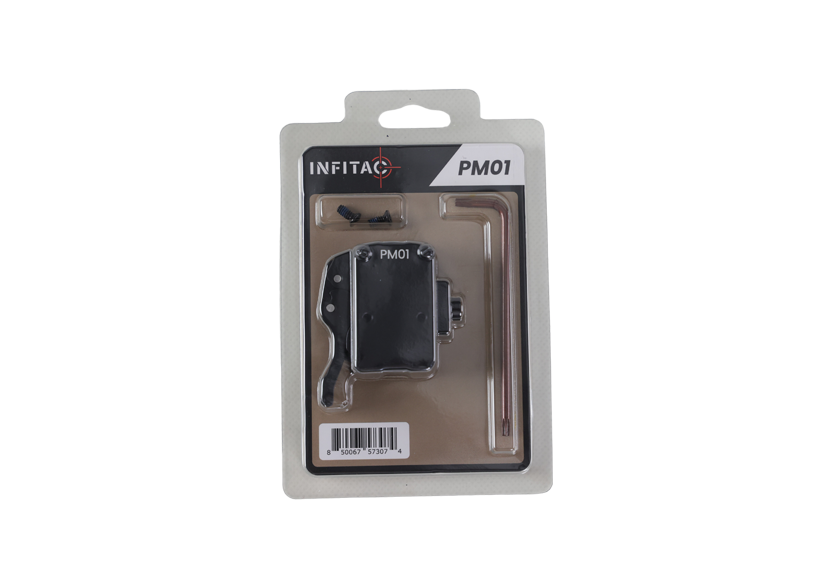The term "thermal red dot" is showing up more and more in the firearms community, and it's causing some confusion. It sounds like a simple combination of two popular technologies, but the name is often used in misleading ways. For shooters, knowing exactly what a piece of equipment does is critical before buying it. This article will explain what a true thermal red dot is, how it differs from other optics, and help you figure out which technology actually fits your needs.
What is a Standard Red Dot Sight?
Before we can dissect the hybrid technology, it's essential to have a solid grasp of its components. The standard red dot sight has long been a staple for competitive shooting and defensive applications because of its simplicity and speed.
How It Works and Core Benefits
A red dot sight is a non-magnifying optic. It uses an LED (light-emitting diode) to project an illuminated dot onto a specially coated lens. From your perspective, this dot appears to be superimposed on your target. This method is dramatically faster than aligning traditional front and rear iron sights, as it allows you to remain focused on the target itself.
Furthermore, red dot sights are generally parallax-free, meaning that as long as you can see the dot and place it on the target, you will be accurate, even if your eye isn't perfectly centered behind the optic. This forgiving nature, combined with the ability to shoot with both eyes open, significantly enhances your situational awareness—a decisive advantage in any dynamic environment.
For Aiming, Not Detecting
It provides you with an excellent point to shoot at, but it does nothing to help you see or distinguish your target any better. At low light levels, it relies on ambient light nearby or a flashlight mounted on your gun to illuminate the target. In complete darkness, although the dot is very easy to spot, the target is not. Hence, it is only an aiming device and not a detecting device.

How Do Thermal Sights Work?
Thermal imaging operates on a completely different principle. It doesn't rely on light at all; instead, it "sees" by detecting heat.
The Science of Seeing Heat
Any object above absolute zero gives off thermal radiation. A thermal imaging scope uses a special sensor known as a microbolometer to read slight differences in this infrared energy. It translates that information into an image that is visible on a small display housed inside the optic. This image is usually in shades of gray (black-hot or white-hot) or different colors. It displays objects' heat patterns that you can see. An animal hiding in heavy foliage or a person in a darkened room can be easily detected since their body heat differs from the cooler environment around them.
Detecting and Aiming in Darkness
The most significant advantage of a thermal sight is that it works in total darkness. It does not need any light from outside to operate and can see through obscurants like smoke and fog that would block visible light and render traditional optics ineffective. This makes it a great tool for night hunting, surveillance of targets, and military missions. For targeting, these sights do not use a dot that is projected on the screen. They offer a digital reticle—crosshairs or other patterns—imposed directly on the screen in front of the thermal image. While some users may find digital reticles less intuitive than traditional red dot sights, they offer customization features and include ballistic compensation capabilities that can be beneficial for experienced shooters. The shooter utilizes this digital reticle to aim at the heat signature he sees.

The "Thermal Red Dot": An Integrated Rifle Solution
Now that we know both technologies, we can address the topic's subject. "Thermal red dot" is a term widely utilized in a number of different contexts, yet there exists a developing technical meaning focusing on one specific type of integrated system.
What a "Thermal Red Dot" Is Not
First, it is crucial to state that not every thermal scope can be called a "thermal red dot." The vast majority of thermal sights on the market, especially traditional monocular-style scopes, use digital crosshairs for aiming. While highly effective, their aiming process does not replicate the unique feel and speed of a true red dot. The term has been co-opted by marketing to describe almost any small thermal imager, creating confusion.
Fusing a Thermal Image and a Red Dot
A "thermal red dot" is a technology that integrates a thermal imaging sensor with a red dot-style aiming sight and presents both on a single screen. The effect is that the shooter receives a thermal view of the world but uses an intuitive, recognizable dot as the point of aim. This combination is not merely a matter of adding a dot to a thermal image, but rather a method for leveraging the capabilities of both systems simultaneously. The technology is currently centered on rifle optics.
Fusing Detection with Aiming
The primary advantage of this hybrid system is that it has excellent detection and quick aiming. A shooter can scan in total darkness, rapidly detect a heat signature, then employ the speedy and intuitive "dot-on-target" technique to aim. For shooters accustomed to the speed of red dots, this is a huge advantage that makes aiming more intuitive than with standard thermal scopes.
What About Thermal Sights for Pistols?
To help define what the definition means, it is helpful to compare the integrated rifle solution to a second group of thermal optics: handgun models. Thermal sights can be placed on pistols, but they are used for a different purpose and do not fit into the "thermal red dot" definition.
Thermal optics are indeed manufactured for pistol platforms. These units are compact and designed to mount on optics-ready handguns. Their main use, however, is largely detection. When a close-quarters defensive encounter occurs at night, the very first and most critical task is positive threat identification. A pistol thermal allows the operator to confirm that a person is in a location that is dark or in the backyard without announcing their own position with a flashlight.
Above all, these pistol optics are not 'thermal red dots' because they do not use a true red dot aiming system; instead, they typically rely on a digital reticle. While their design does prioritize close-range detection, they absolutely support rapid engagement and accurate aiming through their digital reticles. These sights enable both target identification and immediate engagement in darkness, making them effective defensive tools. The key distinction is that they use digital patterns rather than a projected red dot, and they're optimized for close-quarters scenarios rather than the longer-range applications of rifle-mounted systems. Purchasing a pistol thermal with the expectation that it performs exactly like an integrated rifle-mounted thermal red dot could lead to disappointment, as the two systems are optimized for different engagement distances and tactical applications.
Thermal Pistol Sights Fast Mini FMP13
Which Optic is Right for You?
Choosing the right optic depends entirely on your firearm, your budget, and what you plan to do with it. As we've covered, each of these systems has a distinct purpose.
- Standard Red Dot: Choose this for fast, reliable aiming in conditions where you can already see your target. It's an excellent, affordable choice for competition, range shooting, and home defense when paired with a good flashlight.
- Pistol Thermal Sight: This is a specialized tool for handgun owners that combines detection and engagement capabilities. If your main concern is identifying potential threats in the dark at close range and quickly engaging them without revealing your position with a flashlight, this is the right technology.
- Integrated Thermal Red Dot (Rifle): This is the high-end option for rifle users who need both elite detection and fast aiming capabilities. It's ideal for activities like nighttime hunting or advanced tactical scenarios where you need to spot targets in the dark and engage them quickly.
Each of these optical systems is designed for a distinct purpose. The final decision should therefore be based on a realistic assessment of your specific needs and budget.
Equip the Right Optic!
A true "thermal red dot" is a true step up, but only if it is properly labeled as a hybrid rifle sight that combines a thermal sensor with a red dot reticle. It is not a blanket term for just any small thermal device. Distinguishing it from plain red dots and thermals for identifying objects on pistols lets you know what you actually need. The ideal optic is always the one that serves your precise purpose, and making that decision begins with accurate information.
FAQs About "Thermal Red Dot"
Q1: What is the main difference between a standard red dot and a thermal sight?
A: A standard red dot helps you aim quickly by projecting a dot onto a lens, but it cannot help you spot a target in the dark. A thermal sight picks up heat to build an image, and it helps you visualize animals or humans in total darkness, but it typically uses digital crosshairs for aiming, rather than a simple dot.
Q2: Can I use a thermal sight during the day?
A: Yes, you can. Thermal optics work by looking for contrast in heat instead of observing light, so they work equally well in daytime and nighttime environments. This will enable you to detect targets hidden or camouflaged in dark spots even during the light of day.
Q3: Why isn't a thermal sight for a pistol considered a "thermal red dot"?
A: A pistol thermal sight isn't considered a "thermal red dot" because the aiming technology is entirely different. A pistol thermal uses a digital reticle overlaid on a screen, whereas a true red dot sight projects a physical point of light from an LED onto a lens. The key advantage of a pistol thermal sight is its ability to enable a rapid and covert counter-attack after detecting a threat without revealing your position.
Q4: Do I need a special target to zero a thermal scope?
A: Yes, it is strongly advised. A regular paper target won't leave a clear heat signature for a thermal scope to zero. You'll be much better off with a dedicated thermal target with a heat-reflective coating or an isolated heat source like a hand warmer to provide a clear point of aim.
Q5: What is the biggest advantage of a true "thermal red dot"?
A: Its main benefit is that it combines two features in a single system. It gives you the excellent detection of thermal imaging to identify targets in any setting, along with the quick, simple aiming of a regular red dot. This helps you detect a target instantly and aim at it just as fast.








Leave a comment
This site is protected by hCaptcha and the hCaptcha Privacy Policy and Terms of Service apply.